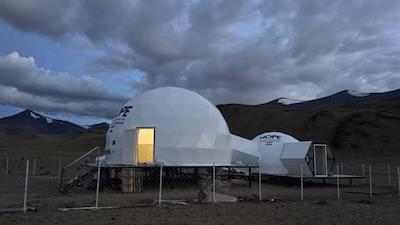
ISRO Sets Up Station in Ladakh to Simulate Life on Moon & Mars
India’s space agency, the Indian Space Research Organisation (ISRO), has made a significant breakthrough in its quest to explore the vast expanse of space. In a bid to prepare for future lunar and Martian missions, ISRO has set up the Himalayan Outpost for Planetary Exploration (HOPE) in Ladakh’s Tso Kar Valley. The state-of-the-art station is designed to simulate life on the Moon and Mars, providing valuable insights into the challenges and opportunities that come with exploring these distant worlds.
Located in the Tso Kar Valley, the HOPE station is situated at an altitude of 15,000 feet above sea level. The valley was chosen for its unique environment, which closely resembles the conditions found on Mars. The region receives high levels of UV radiation, has low atmospheric pressure, and is characterized by extreme cold and saline permafrost. These conditions will test the life-support systems of future lunar and Martian missions, helping ISRO scientists to identify and overcome potential challenges.
The HOPE station is equipped with cutting-edge technology and infrastructure, designed to simulate the harsh conditions found on the Moon and Mars. The station’s life-support systems, including air, water, and food, will be tested over a 10-day period, from August 1 to 10. Two crew members will undertake various tests and experiments at the facility, pushing the limits of human endurance and testing the reliability of the life-support systems.
The HOPE station is a critical step towards India’s ambitious plans to explore the Moon and Mars. ISRO has already made significant progress in its lunar exploration program, with the successful Chandrayaan-1 mission in 2008 and the Chandrayaan-2 mission in 2019. The agency is now focusing on Martian exploration, with plans to send a rover to the Red Planet in the near future.
The HOPE station is not just a simulation facility, but also a testing ground for new technologies and innovations. The station’s infrastructure is designed to be modular and scalable, allowing it to be easily adapted to future missions. The facility will also serve as a training center for astronauts, providing them with hands-on experience in operating in extreme environments.
The Tso Kar Valley, where the HOPE station is located, is a challenging environment that requires special equipment and precautions. The region is known for its extreme cold, with temperatures often dropping below -50°C. The high altitude and low oxygen levels also pose significant risks to the crew members, who will need to be carefully monitored and supported throughout the 10-day simulation.
Despite the challenges, the HOPE station presents a unique opportunity for ISRO scientists to test their equipment and strategies in a simulated environment. The station’s location in the Tso Kar Valley, with its unique Martian-like conditions, provides a rare chance to prepare for the harsh environment that awaits on the Red Planet.
In conclusion, the ISRO’s HOPE station in Ladakh’s Tso Kar Valley is a significant milestone in India’s space exploration program. The station’s ability to simulate life on the Moon and Mars will provide valuable insights into the challenges and opportunities that come with exploring these distant worlds. As ISRO continues to push the boundaries of space exploration, the HOPE station will play a critical role in preparing the agency for its future missions.






